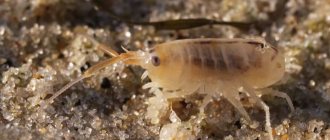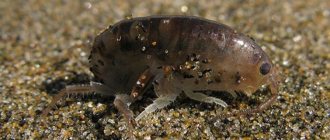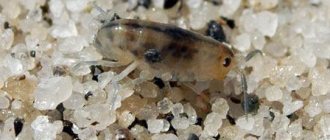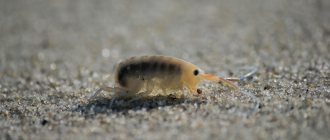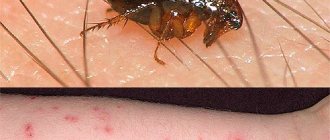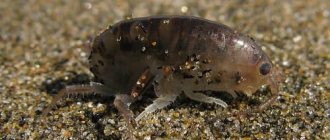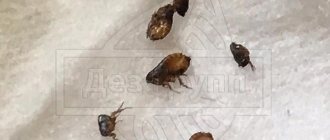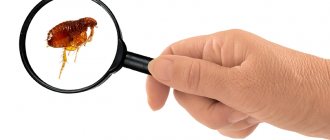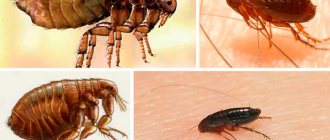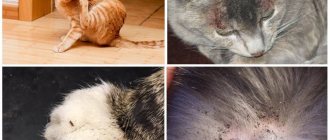Sand fleas are quite dangerous parasites, in some parts of their range creating a serious problem for local health care. The sand flea is not found in northern and temperate latitudes. This is a southern parasite, well known to the inhabitants of Africa and the Caribbean. But don’t be complacent - after it has become fashionable to spend holidays on the shores of the southern seas and conquer unknown lands, the risk of encountering a sand flea increases sharply. Therefore, it is worth knowing how infection with it manifests itself and what to do if it was not possible to avoid an encounter with a flea.
Description
This insect belongs to the genus Tunga penetrans. Sometimes it is called the earthen flea. The flea lives in the sand near the water. In the ground, in the earthen floors of local residents' houses. This parasite lives in:
- Africa,
- South-East Asia,
- South America.
Unlike their other biological relatives, they not only bite and suck blood, but can also bite into the skin and lead to the development of a serious disease, which doctors call sarcopsillosis
The size of the flea is very small - only 1-2 mm. But it is able to jump to a height of up to 35 cm. Fleas are most active in the evening and at night, when they go hunting.
Life cycle
The life cycle of the insect in question is divided into 4 stages:
- The female lays eggs (about 300 at a time), which are round and oblong in shape and are light in color. Eggs develop in 1.5–2 weeks.
- The worm-like larva, about 4 millimeters long, lives in this form for two weeks, feeding on organic debris. Afterwards it grows into a cocoon and takes on the appearance of a pupa.
- After three weeks, an adult flea is born from the pupa (if external environmental conditions are unfavorable, then the insect can remain in the pupa state for up to six months).
- Standard life of an adult.
Breeding cycle
The eggs hatch under a person's skin. That is, a pregnant female pierces the skin and penetrates inside, reaching the blood vessels and sticking to them.
After the eggs are born, the flea dies within 10 days, but it is important to understand that each adult can live for almost six months.
Nutrition
Male fleas feed on the blood of warm-blooded animals, including humans. They do not pose any particular danger to humans, as they can only cause discomfort and unpleasant sensations.
The sand flea feeds on blood, not someone else’s, but ours, human
The same cannot be said about females. For them, a warm-blooded animal is a kind of food factory for offspring. After her fertilization, the female plunges into the layer of human skin and turns into a subcutaneous parasite. As the eggs develop, the female increases in size hundreds of times - from a 2 mm insect, she turns into an insect the size of a pea. As soon as the eggs are ripe, the female shoots them out of the wound and gets out or, more often, dies.
While the female is in the skin, the tissues around her become infiltrated, become inflamed and suppurate.
Natural habitat (+ are they found in Russia)
This type of parasite is common in tropical countries, but the largest number of sand fleas is concentrated in the Caribbean:
- Cuba;
- Dominican Republic;
- Africa;
- Trinidad.
In addition, the insect can be found in Sri Lanka, where it will be large in size. It is almost impossible to avoid encounters with insects in this area, so it is recommended not to expose any parts of the body.
Thailand is completely overrun with these parasites, which constantly spoil people’s holidays, but in terms of their numbers, India is also not far behind, especially since it has favorable conditions for their reproduction and existence.
Sand fleas also exist in Vietnam, but in this case they do not cause any discomfort to tourists, since they are mainly concentrated in dirty cities and towns.
Insects can live everywhere: under stones, in the floorboards of private houses, in the sand on the beach, etc. Insects can also live peacefully on animals. If the parasite finds a victim, it becomes the main source of its nutrition.
The optimal temperature for the reproduction and existence of the parasite is 25–32 oC.
Sand fleas have not yet reached Russia, or their existence has not yet been recorded, because many territories of the Russian Federation have the most favorable conditions for the comfortable life of these insects.
Harm
Fleas cause a disease called tungiasis. It most often affects people from poor areas who rarely wear shoes. Also, the disease has recently affected tourists who do not follow the safety rules for staying in southern countries. Men become infected more often.
The sand flea can lead to the appearance of festering ulcers on the human body
In addition to people, fleas also infect domestic animals - goats, pigs, dogs, causing approximately similar symptoms in them.
Opisthorchiasis: EATEN ALIVE (SIBERIA)
Those who like to relax on the banks of the Ob and Irtysh and fish in the Siberian region face great danger. The fact is that 76% of the fish living in these rivers are infected with the opisthorchid parasite. If you eat such a fish, the larva will enter the body and develop into a parasite that attaches itself to the internal organs and sucks nutrients from them. Most of all, opisthorchids love to live in the gallbladder and liver. Against this background, jaundice often develops, and liver cancer may also occur.
What to do: Beware of eating river fish that has not been boiled or fried, but only salted, wilted or dried. Unfortunately, neither salt nor frost will destroy opisthorchid larvae. You can get rid of them only if you cook the fish for at least 20 minutes at a temperature of 100°C. If after vacation you feel heaviness in the right hypochondrium, you need to consult a doctor - in case of infection, he will prescribe antiparasitic medications.
Photo: Getty Images
Signs of illness
Signs of the disease do not develop immediately. It takes from a week to 12 days before the first symptoms appear. This is due to the fact that all this time the female is growing under the skin.
Most often affected:
- feet;
- nails;
- wrists;
- elbows;
- legs to knees;
- groin and buttocks area;
- stomach;
- back.
There have been cases where the female was found even in the area of the back of the head, pubis, penis, lips, eyelids. Depending on the degree of damage, mild and severe forms of the disease are distinguished.
The death of a female in human skin causes a number of unpleasant symptoms:
- severe itching;
- pain;
- inflammation.
In response to the presence of the parasite in the skin tissue, the body triggers an allergic reaction. The skin turns red. Then the tissues around the parasite swell and begin to become inflamed. As a result, an abscess that resembles a boil forms. Once opened, it turns into an ulcer. If an infection gets into the wound, severe inflammation is possible, which can result in gangrene and sepsis.
Fleas tend to bite humans in certain places. These are, most often, places where the skin is thinnest - the popliteal and armpit hollows, waist, legs (bites especially often appear on the top of the foot and on the sides of the heel bone)
As the eggs develop, the entire time the female is in the skin, fluid may be released from the wound.
Pain and itching can become so severe that a person can hardly move. Unpleasant sensations may intensify at night.
Itching leads to scratching, which can lead to infection in the wound. Microbes that get into the wound cause suppuration and an abscess. Complications of this can include tetanus and gangrene.
But even if it doesn’t come to this, the consequences of infection can be very sad. Tungiasis causes:
- deformation of fingers;
- finger amputation;
- necrosis;
- thrombophlebitis;
- elephantiasis;
- pneumonia.
What they look like
Small parasites visually resemble a dark moving dot. They are confused with ants, bugs, and midges. A distinctive feature of the insect is its jumping ability. Small, jumping crumbs on the beach are a sign that the area is infested with fleas.
You need to know the enemy by sight:
- Adults reach a length of 1.5 to 2 mm.
- The color is dark brown, sometimes with a reddish tint, depending on the habitat.
- Sand fleas have six legs. The hind ones are longer, with the help of them they push off and make a jump up to 40 cm long. This is 200 times the length of the body.
- The body is in the form of a flat droplet, protected by a shell and covered with scales that allow it to cling to any surface.
- Females are larger than males. When eggs are gestated, their size increases.
How to tell if a flea has bitten you
Sand flea bites are similar in strength and pain to mosquito bites. After a bite, the skin appears red and itchy.
A flea bite looks the same as most insect bites: slight redness with firm swelling. The very place where the skin is punctured is usually not visible due to the very small size of the hole and the elasticity of the skin
If the female penetrates the skin, the person begins to feel severe pain, and a swelling appears at the site of the bite with a black abscess in the middle and a white abscess.
Horseflies: carriers of anthrax (SIBERIA, CENTRAL RUSSIA)
While relaxing on the banks of rivers and lakes, you can become a victim of blood-sucking insects - horse flies. This is not only unpleasant, but also dangerous. A horsefly bite is accompanied by severe pain, a thickening forms on the skin, itching and burning appear. In normal cases, symptoms disappear after a few days. However, you should know that horseflies serve as a carrier of dangerous diseases, such as anthrax.
What to do: Horseflies attack only during daylight hours in good weather. To relieve itching, you need to cool the swelling by applying a piece of ice, wash the wound with soap and water, and then burn the bite site with alcohol. Plantain leaf, dandelion or onion juice will also help with pain and swelling.
Photo: Getty Images
Treatment
Tungiasis can only be cured through surgery. As soon as a diagnosis is made and fleas are found in the skin, they need to be removed.
Getting rid of a sand flea that has penetrated the skin is extremely difficult. Many people try to pull out the parasite on their own with a knife or needle, but it is still better not to do this, but to seek help from doctors
The flea is removed with tweezers or using a sterile needle, being careful not to damage it. After removing the parasite, the wound is disinfected and bandaged.
Ways to get rid of sand fleas
There are quite a few means to get rid of sand parasites, and it is important to remember that an insect can develop immunity to the same method (except in cold temperatures), so it is important to try to diversify each procedure.
Chemical means for control
Among the chemicals, the following are considered the most popular and effective:
- Tick Carpet Spray - will help get rid of parasites on fleecy surfaces (carpets, curtains, etc.). After using the product, you must thoroughly vacuum the surfaces and wet clean the house.
Tick Carpet Spray - TRoom Fogger - used to destroy larvae. The product can be used in both non-residential and residential buildings. The treated room is closed for 2 hours, then allowed to ventilate for about 20 minutes. Wet cleaning is also required.
TRoom Fogger flea spray
A person can protect himself from fleas with the help of various sprays and repellents used against ticks, mosquitoes, etc.
Traditional methods
Traditional methods are considered not very effective in fighting insects, but for prevention or as an addition to chemical agents they are used quite often:
- Hanging wormwood in all corners of the house or room where parasites live.
- Provide frequent ventilation, as the insect cannot tolerate low temperatures.
- Also take fabric items and bedding out into the cold and keep them there for several hours. Afterwards treat with a mixture made from salt and soda, then vacuum everything thoroughly.
- It is better to wash the room with a solution made from tansy and nettle.
- Place pine shavings in inaccessible places.
How to prevent bites
You can reduce the risk of flea bites to a minimum. To do this, while in dangerous areas, you must follow the safety rules:
- always wear socks and shoes;
- do not walk on the beach without beach slippers;
- do not sit on the sand;
- wash your feet daily.
When traveling to an exotic country, get the necessary vaccinations and buy the necessary ointments or other means to protect against insects
A sand flea bite is an unpleasant incident. To prevent sad consequences, you must immediately seek medical help and remove the parasite. Then you can be sure that everything will end well.
SALMONELLOSIS: DANGEROUS FOOD
During the holidays there is a surge in the incidence of acute intestinal infections. One of them is salmonellosis. You can catch it if you eat improperly cooked meat or eggs. Symptoms appear within 6 hours or on the third or fourth day. The disease occurs with a temperature of up to 39–40°, accompanied by nausea, vomiting, and diarrhea. At 70°C, salmonella die in about 10 minutes, but in the thickness of a piece of meat they can withstand boiling for several hours.
What to do: It is not recommended to eat undercooked kebabs. Before cooking, eggs should be washed with running water and cooked for at least 20 minutes from the moment they boil. It’s worth giving up the fried eggs.
Insect Reproduction
The fertilization process in fleas lasts about ten hours. This is due to the structural features of the reproductive organs of these insects. The female retracts the genital claw, through which the seed enters the spermatheca. To mate, she first climbs onto the back of the male, who dies after fertilization.
After about a week, the female sand flea begins to lay eggs. After four days, larvae appear that look like small white worms. They do not live on human bodies, preferring earthen mounds or sandy beaches.
The larvae actively feed on organic debris and after a few weeks turn into pupae, from which, under favorable conditions, adult insects subsequently emerge.
Habitats and distinctive symptoms of a bite
Despite the name of these parasites, they can live not only in sand. They adapt well to external conditions and quite often settle closer to human living quarters, since this is how they can provide themselves with food. They can live near any body of water, on farmland, in soil and sand, on bushes and in grass.
It is very easy to become infected with the parasite; just walk barefoot on the beach, lie on the sand, or walk through a green area near a pond. They attack the feet, legs, groin area and even the back. In addition, they can get under the nail, since there is thin skin and many blood vessels.
Wild beaches pose a great danger because they are not cleaned or disinfected. Parasites are also most dangerous in the month of September, since during this period they are most active. Due to their small size, it is impossible to see them among the sand, and a person cannot feel the bite. Only after some time do symptoms appear.
There are differences between the bite of a female and a male. When a male bites, an allergic reaction most often occurs. The place where the parasite bitten becomes very inflamed and accompanied by itching, which does not go away within 2-3 days. In rare cases, allergies can develop into asthma. There are cases where anaphylactic shock occurred.
When a female is bitten, the area becomes inflamed and ulcers form. Without proper treatment, tungiasis develops. This is a very dangerous disease that, without treatment, leads to amputation of a limb. In addition, quite often, due to severe itching, people scratch their bites and get infections, which cause additional complications.
